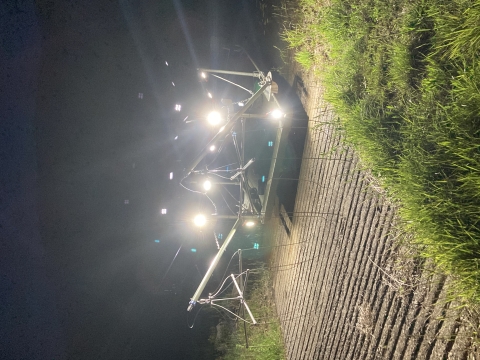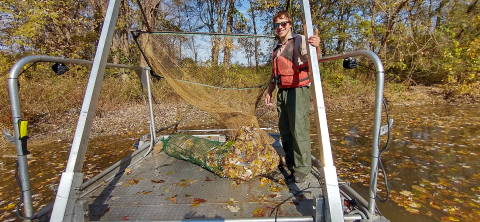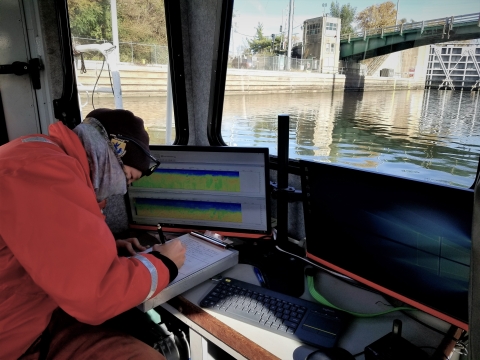What We Do
Combined, the Carterville and Wilmington offices work in several states with many partners to maintain diverse, self-sustaining populations of fish and other aquatic organisms and habitats in the region for the benefit of the American people.
The goals of the office are to:
- Prevent new introductions and minimize the range expansion of aquatic invasive species invasive species
An invasive species is any plant or animal that has spread or been introduced into a new area where they are, or could, cause harm to the environment, economy, or human, animal, or plant health. Their unwelcome presence can destroy ecosystems and cost millions of dollars.
Learn more about invasive species - Early detection and monitoring of silver, bighead, grass, and black carps at the upstream edge of their known range
- Maintain diverse, self-sustaining fish and other aquatic resource populations and their habitats (e.g., removing barriers to fish passage fish passage
Fish passage is the ability of fish or other aquatic species to move freely throughout their life to find food, reproduce, and complete their natural migration cycles. Millions of barriers to fish passage across the country are fragmenting habitat and leading to species declines. The U.S. Fish and Wildlife Service's National Fish Passage Program is working to reconnect watersheds to benefit both wildlife and people.
Learn more about fish passage ) - Ensure sustainable use of natural resources on Department of Defense lands
- Enhance recreational fishing opportunities on national wildlife refuges
- Aid in the recovery of fish and mussel populations protected under the Endangered Species Act of 1973, as amended (16 U.S.C. et seq) and restore declining populations of native species
Management and Conservation
Habitat Programs - Much of the aquatic habitat of the Upper Mississippi River Basin has been degraded by alterations made for river navigation, agriculture, and other forms of development. As a result, many fish and mussel species are endangered, threatened, or imperiled. Because of the magnitude and geographic extent of these issues, the Carterville FWCO works collaboratively with our partners in the basin to identify, plan, and address threats to fish and wildlife resources and conserve and enhance aquatic habitat. We participate on multi-agency teams to address habitat needs on the Mississippi, Illinois, and Ohio rivers. We work primarily through U.S. Army Corps of Engineers (USACE) programs including the Navigation and Ecosystem Sustainability Program, the Environmental Management Program, and the River Resources Action Team. We also participate in activities through the Upper Mississippi River Conservation Committee, Upper Mississippi River Coordinating Council, Upper Mississippi River Basin Association, and Mississippi Interstate Cooperative Resource Association Paddlefish/Sturgeon Committee. In addition, we work with the USACE and the Middle Basin Pallid Sturgeon Workgroup to promote the recovery of pallid sturgeon.
National Fish Passage Program - As part of the National Fish Passage Program the Carterville FWCO works with its partners to identify and develop fish passage fish passage
Fish passage is the ability of fish or other aquatic species to move freely throughout their life to find food, reproduce, and complete their natural migration cycles. Millions of barriers to fish passage across the country are fragmenting habitat and leading to species declines. The U.S. Fish and Wildlife Service's National Fish Passage Program is working to reconnect watersheds to benefit both wildlife and people.
Learn more about fish passage projects in the Mississippi River watershed in Illinois, Indiana, and Ohio. The Carterville FWCO has provided funding and technical assistance for small dam removals, rock-ramp fishways, and road-stream crossings. If you are interested in developing a fish passage project in our area, please contact the Carterville FWCO Fish Passage Coordinator at (618) 997-6869.
Current Fish Passage Projects: Charles Mill Dam, Markle Dam, Big Blue River Dam, Shadyside Park Dam, and East Fork of Whitewater River Dams
Management on Military Installations - The Carterville FWCO assists with the management of fisheries for two military installations: Scott Air Force Base in Belleville, Illinois and Naval Support Activity Crane in Crane, Indiana. Annual spring electrofishing surveys are performed by our biologists to monitor the fish populations in multiple ponds at each base. We prepare management reports for both installations detailing information about the fish populations and recommendations for management actions based on results of the electrofishing surveys. The Carterville FWCO also assists these military bases with other activities as needed (e.g., fish stocking and pond restoration).
Our Projects and Research
Invasive Carp Projects
The Carterville FWCO and Wilmington Substation work with other agencies and partners to expand control and management efforts for invasive silver, bighead, grass, and black carps to a national scale. These efforts include prioritizing the implementation of the Great Lakes Restoration Initiative Action Plan and an annual Invasive Carp Action Plan and complementary Monitoring and Response Plan overseen by the Invasive Carp Regional Coordinating Committee (ICRCC).
Early Detection and Monitoring - Staff at the Carterville FWCO and Wilmington Substation use fish capture gears (e.g., boat electrofishing, electrified dozer trawl, mini-fyke nets) to search for invasive carps at the upstream edge of their known range: the upper Illinois Waterway, Chicago Area Waterway System, the Ohio River, and tributaries of concern (e.g., Des Plaines and Kankakee rivers). Early Detection and Monitoring improves our understanding of the distribution of adult and juvenile carps in relation to the Great Lakes and gives managers the opportunity to respond to any potential spread before these fishes become established.
Carterville FWCO Hydroacoustics - Carterville FWCO staff use hydroacoustic techniques as a part of a comprehensive plan to manage silver and bighead carps throughout the Ohio River Basin. These efforts include surveys of the navigation pools and tributaries of the Ohio River and the evaluation of mass removal events in Kentucky Lake and Lake Barkley. For survey efforts, Carterville staff coordinate with the Indiana Department of Natural Resources and Kentucky Department of Fish and Wildlife Resources to use hydroacoustic sampling, paired with fish community sampling, to estimate the density and spatial distribution of silver and bighead carps. Additionally, Carterville staff collaborate with the U.S. Geological Survey to evaluate the effectiveness of mass harvest events targeted at removing silver and bighead carps in Kentucky Lake and Lake Barkley. For these events, hydracoustic surveys are performed prior to and following the removal event to determine the effectiveness of removal efforts. Both the surveys and the evaluations of removal efforts contribute to the larger goal of managing and controlling silver and bighead carps within the Ohio River Basin.
Carterville FWCO Acoustic Telemetry – Acoustic telemetry in the Ohio River Basin is focused on quantifying lock and dam passage, habitat use, and survival rates of silver and bighead carps throughout a >800 mile stretch of the Ohio River from its confluence with the Mississippi River to Willow Island Lock and Dam (Ohio-West Virginia border). Given the broad expansion and establishment of silver and bighead carps within the Ohio River Basin, understanding their movement patterns and interactions with their environment is critical to management efforts aimed at slowing their spread into novel habitats. Each fish is surgically implanted with an acoustic transmitter, allowing scientists to track their movements using a large array of receivers. This is a large, collaborative effort between the Carterville FWCO and state and academic partners from Illinois, Indiana, Kentucky, Ohio, and West Virginia.
eDNA – Environmental DNA, or eDNA, is species-specific DNA material from an organism that is shed or excreted into the environment. In the Upper Ohio River eDNA sampling is used in addition to other methods to monitor and detect emerging populations of silver and bighead carps. Carterville FWCO staff collects and preserves eDNA water samples in the field. The samples are then processed for silver and bighead carp DNA by Whitney Genetics Lab staff.
Wilmington Substation
Upper Illinois Waterway Hydroacoustics - The Wilmington Substation staff conduct hydroacoustic surveys in the upper Illinois Waterway. Hydroacoustic surveys inform partners (e.g., U.S. Army Corps of Engineers and Illinois DNR) of the presence and abundance of large (>12 inches) fish near the primary barrier preventing silver and bighead carps from reaching Lake Michigan, The Electric Dispersal Barrier System (EDBS) in Romeoville, IL. Examining patterns of fish abundance near the EDBS, and in the reaches (i.e., navigation pools) immediately downstream of the EDBS, helps partners plan EDBS maintenance and manage the risk of silver and bighead carps spreading towards Lake Michigan.
Acoustic Telemetry Support for Invasive Carp Population Modeling - Staff at the Wilmington Substation partner with other agencies to maintain an array of acoustic telemetry receivers in Peoria and Starved Rock pools of the Illinois Waterway. Acoustic telemetry involves implanting transmitters into individual fish to track their movements, habitat use, and behavior. Data gathered from tagged fish help scientists understand invasive carp movement patterns in the Illinois Waterway and how often these fishes move between pools by passing through the Illinois Waterway’s locks and dams.
Barge Entrainment Mitigation - The Wilmington Substation continues to partner with the U.S. Army Corps of Engineers and U.S. Geological Survey to conduct studies evaluating probability that cargo barges, which routinely move between the Mississippi River Basin and the Great Lakes, unintentionally trap fishes (i.e., silver and bighead carps) and transport them between these systems. Barges carrying cargo in the Illinois Waterway often pass through the Electric Dispersal Barrier System (EDBS)—the main fish barrier separating the Mississippi River system and the Great Lakes—on their way to Lake Michigan. Because the steel hulls of barges can deflect the EDBS’ electric field, understanding if barges can trap and move silver and bighead carps will help scientists determine the risk of species transfer by barge traffic, and test the effectiveness of techniques to remove these trapped fish (e.g., bubble curtains).


